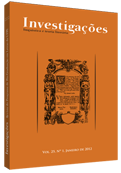Um Sertão, um Drama Seco, e seu Deus Danado: uma leitura antidiscursiva e contraideológica do ideário regionalista e sertanejo na dramaturgia de João Denys Araújo Leite
Abstract
Este trabalho pretende fazer a abordagem de um modelo particularizado de representação mimética do ideário regionalista e sertanejo detectado na literatura dramática de João Denys Araújo Leite, especificamente na produção textual da sua obra Deus Danado, focalizando a forma como o processo de sua criação dramatúrgica contrapõe-se a uma tradição dos mecanismos de representação artística do sertão nordestino brasileiro.References
ARTAUD, Antonin. 1987. O teatro e seu duplo. Trad. Teixeira Coelho. 3. ed. São Paulo: Editora Max Limonad.
BATAILLE, Georges. 1992. A experiência interior. Trad. Celso Libânio Coutinho et al. São Paulo: Ática.
CHAUÍ, Marilena. 1997. Cultura e democracia: o discurso competente e outras falas. 7. ed. São Paulo: Cortez.
DENYS, João. Deus Danado. 1999. Natal: Bastidores Textos de Teatro.
FARIAS, Sônia Lúcia Ramalho de. 2007. Diverso, mas não plural: reconfigurações de um Brasil mestiço em Ariano Suassuna em cotejo com Gilberto Freyre. In: JOACHIM, Sébastien (Org.). Anais do II colóquio Cidadania Cultural: diversidade cultural, linguagens, identidades. Recife: Elógica Livro Rápido. p. 265-271.
FAUSTO NETO, Antônio. 1979. Cordel e a ideologia da punição. Petrópolis: Editora Vozes Ltda.
FREYRE, Gilberto. 1978. Casa grande e senzala. 19. ed. Rio de Janeiro: José Olympio.
GALVÃO, Walnice Nogueira. 1976. Saco de gatos: ensaios críticos. 2. ed. São Paulo: Duas Cidades.
LEITE, João Denys Araújo. 2003. Um teatro da morte: transfiguração poética do bumba-meu-boi e desvelamento sociocultural na dramaturgia de Joaquim Cardozo. Recife: Fundação de Cultura Cidade do Recife.
______. 1999. Deus Danado: uma opção estética pelo homem da terra e seu drama seco. In: –. Deus Danado. Natal: Bastidores Textos de Teatro. p. 3-4.
LIMA, Luiz Costa. 1981. Da existência precária: o sistema intelectual no Brasil. In: –. Dispersa Demanda. Rio de Janeiro: Francisco Alves. p. 3-29.
______. 1988. Aproximação a Jorge Luis Borges. In: –. O fingidor e o censor: no ancién regime, no iluminismo e hoje. Rio de Janeiro: Forense-Universitária. p. 257-304.
MOTA LIMA, Fernando. 1999. Potiguar e potiguares. In: DENYS, João. Deus Danado. Natal: Bastidores Textos de Teatro. p. 2-3.
SUASSUNA, Ariano. 1974. O movimento armorial. Recife: Editora Universitária.
SÜSSEKIND, Flora. 1984. Tal Brasil, tal naturalismo. In: –. Tal Brasil, qual romance?: uma ideologia estética e sua história: o naturalismo. Rio de Janeiro: Achiamé. p.19-88.
Downloads
Published
How to Cite
Issue
Section
License
Copyright (c) 2012 João Augusto de Medeiros Lira

This work is licensed under a Creative Commons Attribution 4.0 International License.
Authors who publish with Revista Investigações agree to the following terms:
Authors retain copyright and grant the journal right of first publication with the work simultaneously licensed under the Creative Commons Attribution 4.0 International (CC BY 4.0) license that allows others to share the work with an acknowledgement of the work's authorship and initial publication in this journal.
Authors are able to enter into separate, additional contractual arrangements for the non-exclusive distribution of the journal's published version of the work (e.g., post it to an institutional repository or publish it in a book), with an acknowledgement of its initial publication in this journal.
You are free to:
Share — copy and redistribute the material in any medium or format for any purpose, even commercially.
Adapt — remix, transform, and build upon the material for any purpose, even commercially.
The licensor cannot revoke these freedoms as long as you follow the license terms.
Under the following terms:
Attribution — You must give appropriate credit , provide a link to the license, and indicate if changes were made . You may do so in any reasonable manner, but not in any way that suggests the licensor endorses you or your use.
No additional restrictions — You may not apply legal terms or technological measures that legally restrict others from doing anything the license permits.

